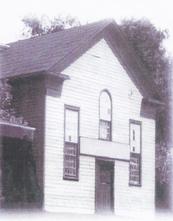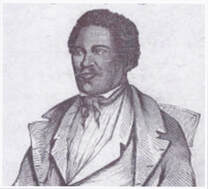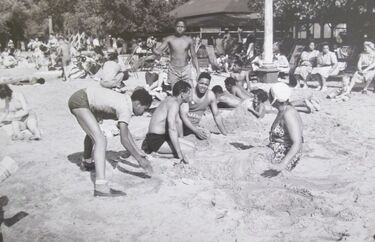Community History

The Zion Baptist Church also served the Black community in St. Catharines.
Elder Washington Christian of Toronto founded this congregation. Christian was a native of Virginia. He relocated to Toronto in 1826 and organized the First Baptist Church. Throughout the 1830's Christian traveled throughout Canada championing the Baptist cause for people of African descent. In 1838, he established a Baptist Society in
St. Catharines.
Two years after the formation of the Baptist Society the members purchased a plot of land from William Hamilton Merritt, a local abolitionist businessman to build the Zion Baptist Church. The church opened in 1844.
One hundred and four years later, after years of struggle, the Zion Baptist Church was closed and demolished due to a lack of maintenance and operational funds and a declining membership. The remaining handful of members relocated to a smaller space on Raymond Street where the members continue to serve the Lord to this day.
Elder Washington Christian of Toronto founded this congregation. Christian was a native of Virginia. He relocated to Toronto in 1826 and organized the First Baptist Church. Throughout the 1830's Christian traveled throughout Canada championing the Baptist cause for people of African descent. In 1838, he established a Baptist Society in
St. Catharines.
Two years after the formation of the Baptist Society the members purchased a plot of land from William Hamilton Merritt, a local abolitionist businessman to build the Zion Baptist Church. The church opened in 1844.
One hundred and four years later, after years of struggle, the Zion Baptist Church was closed and demolished due to a lack of maintenance and operational funds and a declining membership. The remaining handful of members relocated to a smaller space on Raymond Street where the members continue to serve the Lord to this day.
Reverend Anthony Burns

Anthony Burns joined the Zion Baptist Church in 1860. Born enslaved in 1834 Virginia, Burns escaped from bondage travelling by ship to Boston. For a short while Burns was a free man and worked for a clothing dealer. His former enslaver discovered his whereabouts and on May 24, 1854 Burns was arrested under the 1850 Fugitive Slave Act. The Burns case generated national and international attention due to the citizens of Boston organizing massive protests and rioting.
Anthony Burns was returned to a life of enslavement. His Boston friends did not forget about him. They purchased his freedom in 1855. Burns moved to Ohio to study theology at Oberlin College. After he received his degree he moved to Indiana for a short while and by 1860 he settled in St. Catharines and became the Pastor of the Zion Baptist Church. Two years later, Rev. Anthony Burns passed away at the age of 28.
Anthony Burns was returned to a life of enslavement. His Boston friends did not forget about him. They purchased his freedom in 1855. Burns moved to Ohio to study theology at Oberlin College. After he received his degree he moved to Indiana for a short while and by 1860 he settled in St. Catharines and became the Pastor of the Zion Baptist Church. Two years later, Rev. Anthony Burns passed away at the age of 28.
emancipation day

The August 1st Emancipation Day celebrations officially began in 1834 when the British Act to abolish slavery took effect.
The celebrations in St. Catharines were at one time among the largest in the province. A church service, a grand parade and a festive dinner marked the celebration in 1835. Similar celebrations would continue throughout the 1800s.
In the 1920s the event was organized by the Toronto chapter of the Universal Negro Improvement Association (UNIA). At this time the Emancipation Day celebration was moved to the first Thursday in August and relocated to Lakeside Park in Port Dalhousie, a suburb of St. Catharines. It is estimated that upwards to 8,000 or more people from Southern Ontario and Western NY would gather at Lakeside Park each year until about 1951 when the UNIA stopped organizing the event.
The following years saw a gradual decline in participants and by the late 1960s, the large gathering was a fond memory. Since then, up to 300 freedom seeker descendants and their friends gather at Lakeside Park each August to commemorate Emancipation Day in a down home, family reunion type atmosphere.
Thousands of freedom seekers put down permanent roots in Canada West. Some of the historic family surnames that survive among the descendants living in St. Catharines and Niagara today include: Alligood Anderson Bell Brady Bright Bryant Bush Dawson Dorsay Dorsey Erie Flowers Freeman Harper Hogan Hooper Howard Jackson Jamieson Johnson Levines Little Mills Nicholson Phelphs Plato Plummer Price Shadd Smith Summers Talbot Thompson Travis Washington Wilkins Wilkinson Williams Wilson
The celebrations in St. Catharines were at one time among the largest in the province. A church service, a grand parade and a festive dinner marked the celebration in 1835. Similar celebrations would continue throughout the 1800s.
In the 1920s the event was organized by the Toronto chapter of the Universal Negro Improvement Association (UNIA). At this time the Emancipation Day celebration was moved to the first Thursday in August and relocated to Lakeside Park in Port Dalhousie, a suburb of St. Catharines. It is estimated that upwards to 8,000 or more people from Southern Ontario and Western NY would gather at Lakeside Park each year until about 1951 when the UNIA stopped organizing the event.
The following years saw a gradual decline in participants and by the late 1960s, the large gathering was a fond memory. Since then, up to 300 freedom seeker descendants and their friends gather at Lakeside Park each August to commemorate Emancipation Day in a down home, family reunion type atmosphere.
Thousands of freedom seekers put down permanent roots in Canada West. Some of the historic family surnames that survive among the descendants living in St. Catharines and Niagara today include: Alligood Anderson Bell Brady Bright Bryant Bush Dawson Dorsay Dorsey Erie Flowers Freeman Harper Hogan Hooper Howard Jackson Jamieson Johnson Levines Little Mills Nicholson Phelphs Plato Plummer Price Shadd Smith Summers Talbot Thompson Travis Washington Wilkins Wilkinson Williams Wilson
Copyright © Salem Chapel. All Rights Reserved.